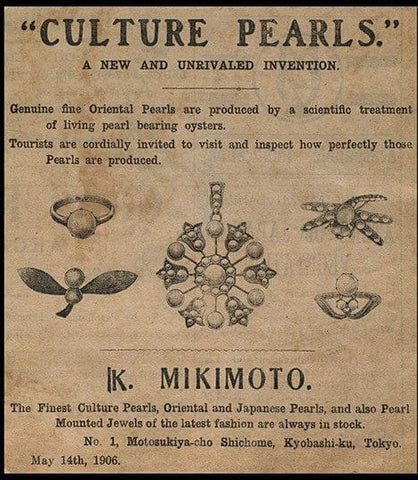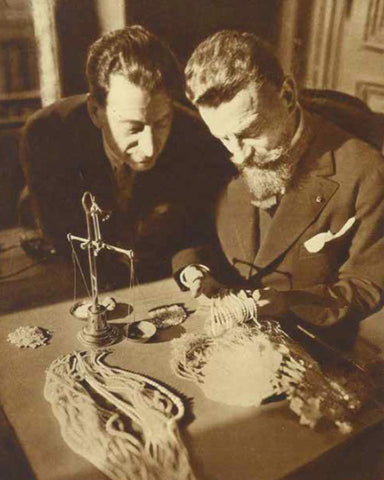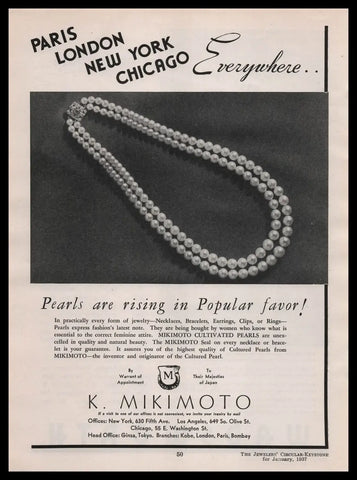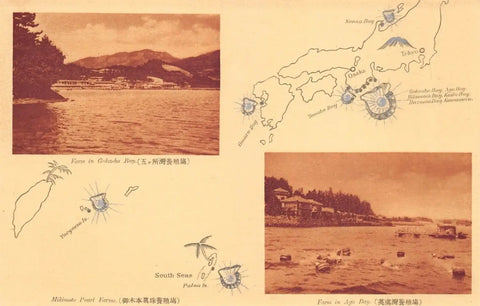
This is the third part in the History of Cultured Pearls blog posts. And here we will immerse ourselves with a little mystery and a lot of legal battles 🕶️🦪🕶️
The Road to Recognition
Mikimoto was fortunate to receive early recognition for his jewelry made from Mabe cultivated pearls. He also achieved international acclaim, winning a medal at the 1900 Paris World's Fair, and again at the St. Louis World's Fair in 1904. He successfully opened stores in Japan, China, Europe, India, and the USA, specializing in the trade of cultivated Mabe pearls. However, gaining recognition for his new round cultured pearl, which he termed "oriental", proved to be a more challenging endeavor.

In France, Mikimoto encountered resistance led by the renowned natural pearl dealer Leonard Rosenthal. Rosenthal sued Mikimoto for fraud, alleging that Japanese pearls were being sold in European markets as natural, without any disclosure of human intervention. Rosenthal argued that Mikimoto's pearls were mere imitations. In 1912, courts in Paris and London declared that Japanese cultured pearls could not legitimately be called pearls. In one of my 'pearl library' books, 'Pearls and Pearling' by Herbert Harvey Vertrees, published in 1913, it is noted that Japanese farm-grown pearls were considered imitations. This was the global perception of Japan's new spherical pearls.
The legal battle was lengthy and complex. Leonard Rosenthal wrote about it in his book 'Pearl Hunter', claiming victory and forcing Mikimoto to drop the term "oriental pearl". Conversely, Mikimoto and his allies argued they had won, as many experts, including English zoologist Henry Lister Jameson, supported him. Jameson stated that scientifically, Mikimoto's pearls were identical to those formed naturally.

Leonard Rosenthal (seated) with his brother Victor. An incredibly interesting family and a fascinating story of natural pearls in Europe at the twilight of their reign."
Decades later, it's said that "after several lawsuits, Mikimoto won the right to label his cultured jewels as pearls". The truth is that from the outset with his Mabe pearls, Mikimoto and his mentor - the technical mastermind behind his success - Japanese Imperial University zoologist Dr. Mitsuruki (a name unjustly forgotten by pearl culture history), referred to these Mabe as "cultured pearls", and their subsequent creation, the spherical pearl, as "oriental". The court stripped this self-designation from the Japanese cultivated pearl and extended the term "cultured" to both Mabe and spherical varieties.
Interestingly, Rosenthal, advocating for both terminological and market purity, inspired his friend, the eminent French scientist Jean Baptiste Perrin, to invent a portable X-ray device. For over a century, gem laboratories have used this device, among other things, to differentiate natural pearls from cultured ones.
After all the legal battles, it was only after the First International Jewelry Congress in 1926 that the international trade recognized and accepted "cultured pearl" as a legitimate term. From then on, all human-intervention grown pearls, including freshwater, Tahitian, South Sea pearls, and all types of Keshi, were known as "cultured pearls". Poor Leonard Rosenthal! Mikimoto's pearls, regardless of their label, conquered the global market. The centuries-old, uncontested reign of natural pearls had ended, never to return.

It should be noted that Mikimoto encountered far fewer difficulties in the US market compared to Europe: pragmatic Americans were indifferent to the naming of the new, more affordable pearls! By 1931, Mikimoto Pearls had become a global presence, with 51 pearl farms flourishing in Japan. By 1938, the number of pearl farms in Japan had increased to over 360, peaking at a production of nearly 11 million pearls annually! During this golden era, Akoya pearls were cultivated for 4 years (now this is done in just 12-18, very rarely 24 months). The popularity of cultured pearls grew in tandem with this production increase, and it seemed limitless. However, a huge and tragic event was on the horizon, which, albeit briefly, altered the trajectory of the Japanese pearl industry.
Post-World War II
World War II caused substantial damage to Mikimoto's burgeoning business. Much of the Japanese pearl industry was decimated. Mikimoto's flagship store in Tokyo's Ginza district suffered the same fate as much of the capital. Still, not all pearl farms ceased operations, though their number significantly dwindled. By 1946, production in Mie Prefecture had fallen to 370,000 pearls (down from 7 million in 1938), with other prefectures experiencing similar production losses.

Following Japan's surrender, the occupying forces took a keen interest in the nation's pearl industry. General MacArthur's administration encouraged the Japanese to resume full-scale production. Concurrently, the Supreme Commander of the Allied Forces mandated that all production could be sold only through the Central American Supply Administration. This led to all cultured pearls being either exported to the United States or sold to American military personnel and their families in Japan. The Japanese pearls became immensely popular, even among ordinary soldiers. The most sought-after item was a graduated strand weighing 3.5 momme (just over 13 grams), with pearls ranging from three to just over seven millimeters in diameter. Hundreds of thousands of such strands reached the US, marking the true beginning of America's love affair with cultured pearls.

From my perspective, this is indeed true. The Mikimoto 3.0-7.0 mm strand was a common gift for daughters, wives, and girlfriends of American military personnel. Enlisted men could afford a strand with a silver clasp, while officers opted for 14 or 18-carat gold. These post-war strands are often found on eBay. In almost every American jewelry box, there appeared at least one modest strand of Mikimoto pearls. I have one too. 🙂

3.6 momme strand from Mikimoto from my own collection. Actually, this the exact one that was my first ever pearl necklace, that sparked my interest in pearls and led me down that rabbit hole of pearl love and affection. True story! 😊

